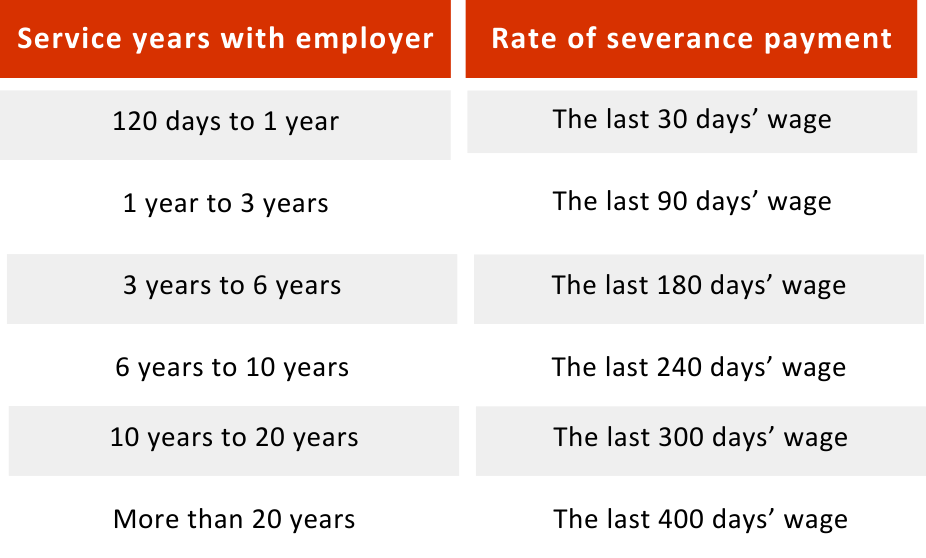Thailand is generally not known to be a litigious country, yet when it comes to labour related disputes, it is a different story.
Based on the Annual Statistical Report conducted by the Thai office of the Judiciary, there have been over 10,000 labour disputes cases annually over the past 5 years.
One of the most common issues faced by employers in Thailand is the claim for unfair termination by their employees. Thailand is known to be a “pro-employee” jurisdiction, meaning the labour protection laws are very protective of employees and termination of employees without good reasons are generally frowned upon by the Courts (as well as culturally). Hence, unfair termination claims are not uncommon, and often create significant financial and resourcing problems for foreign and local employers.
In this article, we address the general legal principles surrounding unfair termination in Thailand, common claims for unfair termination brought by employees, what employers can do to minimise the risk of such claims and how employers can manage the claims if and when they arise.
General legal principles regarding unfair dismissals
Generally, under the Labour Protection Act B.E. 2541 (1998) (LPA) in Thailand, employers must pay severance pay to the employee upon termination, unless the termination was “with cause” for specific categories listed in section 119 of LPA. Employers are not required to pay severance pay in very limited circumstances, including where the employee has been terminated due to dishonesty, committing a criminal offence, intentionally or negligently causing damage to the employer, violating work rules, neglecting duty without justifiable reason or due to imprisonment.[1]
Therefore, if the employee is terminated “without cause”, then severance and other statutory payments must be made to the employee.
Severance pay is calculated by reference to the employee’s last wages and the number of days the employee has worked for the employer.[2]
For a list of statutory payments that need to be made in addition to severance pay, please see our article on Termination of Employment in Thailand here.
Even where the termination is “without cause” and the employer pays all the statutory payments to the employee, there is still a possibility that the aggrieved employee may bring a claim for “unfair termination” in the Thai courts. There is no clear definition of what constitutes “unfair” and the Thai Courts will decide if there were reasonable grounds to terminate the employee on a case-by-case basis, not usually from an employer’s perspective.[3] Therefore, to minimise the potential exposure of unfair termination, we suggest that the employer consult a Thai lawyer even at the stage of considering to terminate an employee in Thailand.
Common claims for unfair termination
Based on our experience and Court precedents, the main causes for unfair termination broadly fall into the following categories:
(1) The employer discriminates against or persecutes a specific employee in management, resulting in the termination of their employment.
(2) There was no valid reason for termination, and insufficient notice was given to the employee.
(3) The employee did not meet the performance criteria, but the employer did not officially warn the employee nor provide an opportunity for training and improvement for the employee.
(4) The termination was due to a mistake by the employee, but it was not a severe or significant mistake.[4]
(5) The termination was due to a petty mistake or minor violation of disciplinary rules without written warning.[5]
(6) The termination was due to a loss of profit, but the employer did not face a significant loss in its principal capital.[6]
(7) The termination was due to the employer’s own reasons (such as redundancy/reorganisation/restructuring or transfer of business) even though the business was still profitable and/or not facing significant losses.[7]
(8) The employee was forced or coerced to resign and/or sign a resignation letter or mutual separation agreement.
What employers can do to minimise the risk of unfair dismissal claims
In practice, the most common reason why employers want to terminate an employee is due to the employee’s poor performance or lack of ability to get along with other employees.
In such situations, the most effective way to terminate an employee and minimising the risk of an unfair dismissal claim is to:
(1) give sufficient notice to the employee of his/her performance so that it does not come as a “surprise” to the employee when he/she is terminated. The notice should contain detailed examples of the employee’s performance and/or behaviour and a performance improvement plan (PIP). These should be communicated verbally and in writing to the employee;
(2) if the employee’s performance does not improve, prepare a termination letter and provide reasons for the termination in the termination letter. Where possible, the employee should be encouraged (but not forced) to resign;
(3) ensure that all statutory payments and contractual entitlements are paid to the employee; and
(4) where possible, enter into a Mutual Separation Agreement with the employee (often with an additional “ex-gratia” payment) containing confidentiality clauses and a waiver of claims.
In addition, if the grounds of termination fall into any of the following categories, the employer should bear the following factors in mind:
Where the termination is due to the company’s redundancy/reorganisation/restructuring
-
-
- The employer must ensure that firstly, it possesses evidence to show that the termination was necessary, as the company is in need of reorganisation/restructuring due to financial difficulties; secondly, that its selection process in determining who to terminate was fair; and thirdly, its actions were consistent with the company’s financial position. For example, where an employer terminated some employees as its business was not doing well but treated all employees the same on termination and did not refill the positions, the Court considered the termination fair.[8] Even if the employers later hired other people to fill in the positions, as long as there was sufficient length of time between the terminations and re-hiring, the termination of the employees as deemed to be fair.[9]
-
- When termination is due to redundancy, reorganization, or restructuring due to improvements or changes in machinery or technology, the employer must notify the termination date, reason for termination, and names of the affected employees to the labor inspection officer and the employees at least 60 days before the termination date. The employer is still required to pay severance pay and if the employer fails to notify an employee in advance, or provides less notice than the period prescribed, the employer must also pay “Special Severance Pay in lieu of advance notice” equivalent to the Employee’s last rate of Wages for 60 days[10]. In addition, if the employee has worked for an uninterrupted period of more than six years, the employer will also be required to pay “Special Severance Pay” in addition to Severance Pay of an amount not less than the Employee’s last rate of Wages for fifteen days for each year of employment. [11]
-
Where the termination is due to office or workplace relocation
-
-
- The employer must announce the details, including the names of the affected employees, the new location’s address, and the relocation date, at the workplace where employees can easily be notified at least 30 days before the relocation. If the relocation significantly affects the employee’s normal living conditions and the employee does not wish to work at the new location, the employee must inform the employer within 30 days of the announcement. In such cases, the employer is obligated to pay “special severance pay”[12].
-
In the event that there is a business transfer
-
-
- The transferor/employer must bear in mind that there is no automatic transfer of employees to the transferee/new employer. Therefore, the employer must ensure that consent is obtained from the employees and the transferee must also continue to provide the employees with the same rights and terms of employment. If an employee objects to being transferred to the transferee/new employer, then the transferee must consider entering into a new contract with the employee or terminate the employee with all the statutory payments and contractual entitlements.
-
How employers can manage unfair termination claims if and when they arise
Notwithstanding the above, if the employee still brings a claim for unfair termination, the employer should consider taking the following steps:
(1) Note the date of the first hearing and instruct local lawyers who specialise in labour claims and are familiar with the Thai Court process. Consider whether an extension of time needs to be requested for filing a Defense.
(2) The employer should consider and gather evidence of its grounds for termination (e.g. showing the employee’s poor performance/behaviour, company’s financial performance, fair selection process etc.) and any grounds to refute the employee’s claims.
(3) Consider if there is room for negotiation and settlement with the employee considering the amount of compensation the Thai Courts may award the employee if he/she is successful in the claim. The Thai Courts will usually encourage the parties to negotiate and enter into a settlement at the first hearing (and throughout the process).
(4) If a settlement can be reached, ensure that a settlement agreement is prepared and contains clauses such as confidentiality and waiver of further claims.
Conclusion
Whilst unfair termination claims are fairly common in Thailand, there are ways to avoid or minimise the risk of such claims as set out above. Employers in Thailand should be aware of the requirements under the LPA and ensure that steps are taken to avoid unnecessary exposure when terminating employees. If an unfair termination claim is brought against them, there are also practical ways in which the employer can take control of the process to reduce the burden of such claims, saving time and costs for the company.
For more information on termination of employment in Thailand, please contact the authors.
[1] Section 119 of the LPA.
[2] Section 118 of the LPA.
[3] Supreme Court Decision No. 1256-1259/2549, 5509-5510/2550, 4505-4506/2557.
[4] Supreme Court Decision No. 16805/2555.
[5] Supreme Court Decision No. 1864/2526.
[6] Supreme Court Decision No.7083/2548, 933/2546 and 1256-1259/2549.
[7] Supreme Court Decision No.6099/2556.
[8] Supreme Court Decision No. 4753-4760/2003.
[9] Supreme Court Decision No. 10659-10665/2003.
[10] Section 121 of the LPA.
[11] The total of this Special Severance Pay should not exceed the Employee’s last rate of Wages for 365 days. Nonetheless, where a period of employment is less than one year, a fraction of the period of employment of more than 180 days shall be counted as one year of employment.[11]
[12] Section 120 of the LPA.



